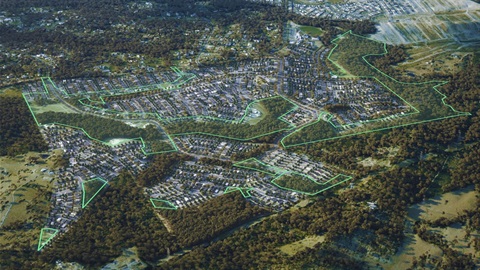Developers Conditioned to Go Green As We Grow
Published 04 January 2023

It might sound counter-intuitive, but developers have protected hundreds of hectares of native habitat around Moreton Bay thanks to approval conditions enforced by Council.
This action is one way Council’s responding to community concerns that the pace of development is outstripping environmental protections.
Mayor Peter Flannery said Council had heard the message loud and clear.
“While we can’t stop growth, we can grow better by being smarter and we know you want us to be more strategic about this,” he said.
“It means in 2023 we’ll need to have a very serious conversation about infill developments, so we construct new housing around our established centres and stop further urban sprawl.
“We will also be releasing our very first Environment and Sustainability Strategy, with an ambitious climate target. Which will be hard, but necessary work.
“Fortunately, I’m proud to be able to say Council’s already doing much better now than in the past.
“Over the past two years alone the conditions we’ve put on development approvals have preserved 500 hectares or enough land to cover the Gabba 200 times over!
“When a developer submits an application to Council, we require them to give something back to the community.
“Sometimes that comes in the form of new roads and infrastructure to support the growth they’re creating, but we also require them to give back land for environmental purposes to protect our wildlife, and greenspaces for parks, sports, and other recreational facilities for residents to enjoy.
“For example, we’ve been able to secure 30,000 new trees to be planted by developers over the past two years.
“We know that development has to happen in Moreton Bay to keep up with the growth demands of South East Queensland and to provide homes for people during the current housing crisis.
“But I want locals to know that your Council has heard loud and clear your concerns about development as our region continues to grow - it’s a concern I share too - which is why we’ve been diligently acting to offset development by preserving hundreds of hectares of land.
“That’s why we’re acting now to minimise the impact that growth has on our local environment and residents’ lifestyle.”
Christine West from Moreton Bay Wildlife Hospital Foundation, has recently successfully lobbied for environmental offsets on numerous Development Applications at Warner, said she was pleased with Council’s direction.
“I would like to acknowledge this Council and thank them for listening and responding to those ongoing communities’ concerns,” she said.
“I believe this approach is industry best practice and I hope that it’s incorporated in all future development applications, so we can put our region first each and every time.
“I think there is always more that needs to be done to better protect our environment from future development, but I believe the foundations are there to build a better Moreton Bay.”
Urban Development Institute of Australia Queensland, Moreton Bay Branch president Keith Cairns said developers were committed to balancing the needs and priorities of a growing population, while maintaining the ecological values and the lifestyle that we all expect.
“As developers we want to ensure we’re doing everything we can to balance those priorities,” he said.
“Moreton Bay, along with many other areas of the State, are experiencing a period of growth and change this means that we need to continue to balance those priorities to ensure we are delivering a better future for everyone.”
Mayor Flannery said there were many examples of developments across Moreton Bay where the environment had been looked after through development application offsets.
“At Kinma Valley, formerly Pine Valley, we’ve received 95 hectares of land alone from the developer for environmental reserve and open space for wildlife and residents to enjoy,” he said.
“Additionally, the developer has chosen to preserve a further 187.2 hectares of land themselves for environmental purpose only, which is an amazing bonus for the community.
“This is just one of many examples where Council is using development applications to offset development right across the region as we continue to ‘Green as we Grow’.
“Like the 15 hectares of open space we got back at Gibbons Road, Samford Valley, the 9,533 square meters of vegetation and koala habitat that was protected at Caboolture River Road, Rocksberg, or the lake, park and open space that was transferred from the developer at Capestone Estate into Council’s hands to maintain and preserve, and so many more.
“We have a number of separate initiatives that complement this work, like the Land Buyback For Environmental Purposes program, which has so far purchased 83 hectares of land for wildlife since 2020.
“We’re continuing to build green infrastructure like koala and wildlife crossings, koala fencing to protect them from roads, and this year we’re rolling out a record tree-planting program with 210,000 new trees.
“There isn’t one single solution to cater for the growth we’re seeing, but through a number of initiatives Council is working to preserve our beautiful region for future generations to enjoy for years to come.”